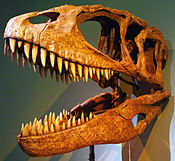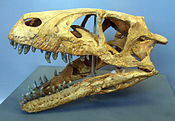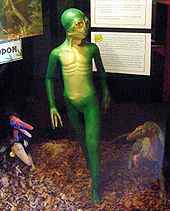- Dinosaur intelligence
-
Dinosaur intelligence has been a point of contention for paleontologists. Dinosaurs were once regarded as being extremely stupid animals but have largely been appraised more generously since the dinosaur renaissance. This new found optimism for dinosaur intelligence has led to highly exaggerated portrayals in pop cultural works like Jurassic Park. Paleontologists now regard dinosaurs as being very intelligent for reptiles, but generally not as smart as mammals. Some have speculated that if the K-T extinction event had not occurred, the more intelligent forms of small theropods may have eventually evolved human-like levels of intelligence. Popular misconceptions of dinosaur neurology include the concept of a second brain in the pelves of stegosaurs and sauropods.
Contents
Dinosaur brain volume and encephalization quotient
Traditional comparisons of brain volume to body mass in dinosaurs have estimated brain size as the volume of the endocast.[1] However, the brain of the modern reptile genus Sphenodon fills only about half of its endocranial volume.[2] Some paleontologists used this fifty percent estimate in their estimates of dinosaur brain volume.[1] Other workers have observed that details on the endocranial surface indicates that some fossil reptiles had brains that occupied a much larger portion of the endocranium.[3] Hans Larsson notes that the transition from reptiles to birds prevents using a set ratio from being a valid approach to estimating the volume of the endocranium occupied by a dinosaur's brain.[3]
Theropod brains
In a 2001 study of a Carcharodontosaurus saharicus endocast, Hans C. E. Larsson found that both C. saharicus and Allosaurus had a ratio of cerebrum to brain volume that lay within the 95% confidence limits of non-avian reptiles.[4] By contrast, Tyrannosaurus lies just outside it in the direction of a more avian proportion.[4] Since tyrannosaurs are relatively basal coelurosaurs, this is evidence that the advent of the Coelurosauria marks the beginning of trend in theropod brain enlargement.[4]
Allosaurus fragilis
The brain of Allosaurus fragilis resembled that of the related form Carcharodontosaurus saharicus.[5] In both species the vena capitis dorsalis "drained the anterior neck muscles through a pair of long canals on the posterior surface of the endocast."[6]
Carcharodontosaurus saharicus
In 2001, Hans C. E. Larsson published a description of the inner ear and endocranium of Carcharodontosaurus saharicus.[7] The C. saharicus braincase "completely encloses the endocranial region." This "high degree of ossification" made detailed analysis of its anatomy significantly easier.[5] The C. saharicus endocast is similar to that of a related dinosaur, Allosaurus fragilis.[5] Larsson describes the olfactory bulbs and peduncles as lying "on approximately the same horizontal plane as the forebrain."[8] The midbrain is angled downwards and towards the rear of the animal, while the hind brain is roughly parallel to the forebrain.[8] The cephalic flexure, the bend between the fore- and midbrain, has an angle of 45 degrees.[9] The pontine flexure, the bend between the mid- and hindbrain has an angle of about 40 degrees.[9] Carcharodontosaurus had a large optic (II) nerve.[10] The C. saharicus vena capitis dorsalis" drains the anterior neck muscles through a pair of long canals on the posterior surface of the endocast."[6] This configuration is found in Allosaurus and Dromaeosaurus albertensis, although in C. saharicus and Troodon "the transverse sinus probably drained into a middle cerebral vein that exited the brain in the ridge present on the dorsal edge of the trigeminal foramen."[6]
Traditional comparisons of brain volume to body mass have estimated brain size as the volume of the endocast.[1] However, the brain of Sphenodon fills only about half of its endocranial volume.[2] Some paleontologists used the fifty percent estimate to ascertain the brain size of dinosaur endocasts.[1] Other workers have observed that details on the endocranial surface indicates that some fossil reptiles had brains that occupied a much larger portion of the endocranium.[3] Larsson notes that the transition from reptiles to birds prevents using a set ratio from being a valid approach to estimating the volume of the endocranium occupied by a dinosaur's brain.[3]
Adding difficulty to examining the ratio of the brain volume of a dinosaur to its body mass is the wide range of estimates for live mass.[3] Larsson observes that one study which estimated the live masses for many dinosaur genera typically had a four fold range.[3]
Larsson laments that "[t]he broad ranges of body mass estimates, combined with the ambiguous ratio of endocranial volume occupied by the brain, present a high degree of uncertainty for [creating an] index of brain size."[3] Consequently, he attempted to minimize errors in his study by making a different kind of comparison.[3]
Noting that while it is difficult to estimate the absolute volume of the brain, the proportions of its various regions should the same in the endocast as it was in the large brain Larsson's study compared the ratio of the cerebrum, which is highly demarcated, to the rest of the endocast's volume.[3] However, if the thickness of the dura covering the various parts of the brain itself differed, then that could alter the relative proportions within the endocast.[3] In Caiman the dura covering the medullary region seemed to increase proportionally in thickness compared to the dura covering the forebrain, although this might not impact the ratio between the regions.[3] Nevertheless, Larsson reaffirmed the superiority of his technique to traditional comparisons of brain volume to estimated live body mass.[3]
Larsson reports that "[a]s brain mass increases, cerebral mass increases with slight negative allometry in nonavian reptiles," Larsson concludes, larger nonavian reptile have proportionately smaller cerebra than smaller ones.[11] Further, the opposite is true in birds, larger avian brains have cerebra which are slightly larger, proportionally speaking.[11] Larsson found that C. saharicus lay within the 95% confidence limits of the nonavian reptile ratio.[4]
Tyrannosaurus
Tyrannosaurus lies just outside the 95% confidence limits of the nonavian reptile ratio of cerebrum volume to whole brain volume in the direction of a more avian proportion.[4] This is in contrast to Carcharodontosaurus saharicus and Allosaurus fragilis, which lie firmly within the reptilian range.[4]
Troodon
Troodon's cerebrum-to-brain-volume ratio was 31.5% to 63% of the way from a nonavian reptile proportion to a truly avian one.[12]
Dromaeosaurus albertensis
In Dromaeosaurus albertensis, the vena capitis dorsalis" drains the anterior neck muscles through a pair of long canals on the posterior surface of the endocast."[6] This configuration is also found in Allosaurus fragilis and Carcharodontosaurus saharicus, according to a 2001 study of a C. saharicus endocast.
Archaeopteryx
Archaeopteryx had a cerebrum-to-brain-volume ratio 78% of the way to modern birds.[13]
Limosa gypsorum
One discrepancy is the ratio possessed by the Eocene bird Limnosa gypsorum, which was only 63% of the modern bird ratio.[14] However, this may be explainable if the endocast was distorted, as it had been previously depicted in the past by Deschaseaux, who is described by Larsson as portraying the endocast "slightly anteroposteriorly sheared and laterally compressed."[13]
"Two brains" myth
Sapient dinosaurs
Toyota (1977)
Aritsune Toyota (豊田有恒), a Japanese science fiction writer was one of the earliest proposers of the idea of Sapient dinosaurs.[15] Toyota was intrigued by the theory of the "Warm-blooded Deinonychus" (John Ostrom, 1964) and developed the idea that some kinds of dinosaurs would have evolved to acquire intelligence. He referred to The Hot-blooded Dinosaurs (Desmond, Adrian J., 1975, Rosemarie Buckman, Oxfordshire) and constructed a theoretical model of what they might have been like.[16] He first published his ideas as science fiction in the novel Kako no kageri (『過去の翳』, A shadow of the past) in 1977. In the story he described them as reptilian humanoids who use bone tools for hunting, speak a primitive language, and build a rudimentary society. The creature was supposed to have evolved from a dinosaur similar to dromaeosaurus.
A year later, Toyota received advice from Japanese zoologist Tatsuo Saneyoshi (實吉達郎), and began striving for more zoological authenticity on details. He then authored Zoku jikanhō keikaku (『続・時間砲計画』, Prospectus for the spatiotemporal cannon part 2). He continued to study thropoda, and serialized his novel as Dainosaurusu sakusen (『ダイノサウルス作戦』, The plan of the dinosaurs) in 1979.
Sagan (1977)
In his 1977 book, The Dragons of Eden: Speculations on the Evolution of Human Intelligence, author Carl Sagan speculated about the related genus Saurornithoides evolving into ever more intelligent forms in the absence of any extinction event. In a world dominated by Saurornithoides, Sagan mused, arithmetic would be Base 8 rather than Base 10.
Jerison (1978)
American psycologist Harry Jerison suggested the possibility of sapient dinosaurs. In 1978, he gave a presentation titled "Smart dinosaurs and comparative psychology", at a meeting of the American Psychological Association. According to his speech, dromiceiomimus supposedly could have evolved into a highly intelligent species like human beings.[16]
Russell (1982)
In 1982, Dale Russell, curator of vertebrate fossils at the National Museum of Canada in Ottawa, conjectured a possible evolutionary path that might have been taken by the dinosaur Troodon had it not perished in the K/T extinction event 65 million years ago, suggesting that it could have evolved into intelligent beings similar in body plan to humans. Over geologic time, Russell noted that there had been a steady increase in the encephalization quotient or EQ (the relative brain weight when compared to other species with the same body weight) among the dinosaurs.[17] Russell had discovered the first Troodontid skull, and noted that, while its EQ was low compared to humans, it was six times higher than that of other dinosaurs. If the trend in Troodon evolution had continued to the present, its brain case could by now measure 1,100 cm3; comparable to that of a human. Troodontids had semi-manipulative fingers, able to grasp and hold objects to a certain degree, and binocular vision.[18]
Russell proposed that this "Dinosauroid", like most dinosaurs of the troodontid family, would have had large eyes and three fingers on each hand, one of which would have been partially opposed. As with most modern reptiles (and birds), he conceived of its genitalia as internal. Russell speculated that it would have required a navel, as a placenta aids the development of a large brain case. However, it would not have possessed mammary glands, and would have fed its young, as birds do, on regurgitated food. He speculated that its language would have sounded somewhat like bird song.[18][19]
Russell's thought experiment has been met with criticism from other paleontologists since the 1980s, many of whom point out that his Dinosauroid is overly anthropomorphic. Gregory S. Paul (1988) and Thomas R. Holtz, Jr., consider it "suspiciously human" (Paul, 1988) and Darren Naish has argued that a large-brained, highly intelligent troodontid would retain a more standard theropod body plan, with a horizontal posture and long tail, and would probably manipulate objects with the snout and feet in the manner of a bird, rather than with human-like "hands".[19]
See also
In popular culture
Footnotes
- ^ a b c d "Allometric Comparison," Larsson (2001). Page 25.
- ^ a b "Allometric Comparison," Larsson (2001). Pages 25-26.
- ^ a b c d e f g h i j k l "Allometric Comparison," Larsson (2001). Page 26.
- ^ a b c d e f "Allometric Comparison," Larsson (2001). Page 29.
- ^ a b c "Description," Larsson (2001). Page 20.
- ^ a b c d "Description," Larsson (2001). Page 23.
- ^ "Abstract," Larsson (2001). Page 19.
- ^ a b "Description," Larsson (2001). Pages 20-21.
- ^ a b "Description," Larsson (2001). Page 21.
- ^ "Description," Larsson (2001). Page 22.
- ^ a b "Allometric Comparison," Larsson (2001). Page 27.
- ^ "Allometric Comparison," Larsson (2001). Pages 29-30.
- ^ a b "Allometric Comparison," Larsson (2001). Page 30.
- ^ Considered a Numenius species in "Allometric Comparison," Larsson (2001). Page 30.
- ^ Saneyoshi, Tatsuo (2006) (in Japanese). Hontō ni ita fushigina ikimono: Jinrui to dōbutsu no sosentachi [Unaccountable creatures that really existed: The ancestors of human and other animals]. Tokyo: PHP Kenkyūjo. pp. 41-48. ISBN 9784569654423.
- ^ a b Kaneko, Ryūichi (1997) (in Japanese). Shin kyōryū densetsu : Saiko kyōryū eoraputoru kara kyōryū jinrui made kyōryūgaku no saisentan [New dinasaur book: The front-lines of dinosaurology, from Eoraptor as the earliest dinosaur to Sapient dinosaurs]. Tokyo: Hayakawashobō. pp. 204-206. ISBN 9784150502119.
- ^ Cosmos: Smartosarus
- ^ a b Russell, D. A.; Séguin, R. (1982). "Reconstruction of the small Cretaceous theropod Stenonychosaurus inequalis and a hypothetical dinosauroid". Syllogeus 37: 1–43.
- ^ a b Naish, D. (2006). Dinosauroids Revisited Darren Naish: Tetrapod Zoology, April 23, 2011.
References
- Larsson, H.C.E. 2001. Endocranial anatomy of Carcharodontosaurus saharicus (Theropoda: Allosauroidea) and its implications for theropod brain evolution. pp. 19–33. In: Mesozioc Vertebrate Life. Ed.s Tanke, D. H., Carpenter, K., Skrepnick, M. W. Indiana University Press.
External links
Animal cognition Cognition - Animal communication
- Comparative cognition
- Cognitive ethology
- Neuroethology
- Elephant cognition
- Emotion in animals
- Pain in animals
- Primate cognition
- Observational learning
- Tool use by animals
- Vocal learning
Intelligence - Bird
- Cat
- Cephalopod
- Cetacean
- Dinosaur
- Dog
- Fish
- Hominid
- Swarm intelligence
Categories:- Dinosaurs
Wikimedia Foundation. 2010.



